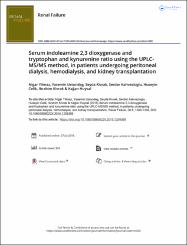Serum indoleamine 2,3 dioxygenase and tryptophan and kynurenine ratio using the UPLC-MS/MS method, in patients undergoing peritoneal dialysis, hemodialysis, and kidney transplantation

Göster/
Tarih
2016Yazar
Yılmaz, NigarÜstündağ, Yasemin
Kıvrak, Şeyda
Kahvecioğlu, Serdar
Çelik, Hüseyin
Kıvrak, İbrahim
Huysal, Kağan
Üst veri
Tüm öğe kaydını gösterÖzet
Background: The level and activity of indoleamine 2,3-dioxygenase (IDO) and the concentrations of L-tryptophan and its metabolite L-kynurenine were determined in association with various renal diseases. However, there have been no data regarding these parameters in patients on peritoneal dialysis compared to those undergoing hemodialysis or kidney transplantation.Methods: This study investigated the level and activity of IDO and determined oxidative balance by calculating the total oxidant status (TOS), total antioxidant status (TAS), and oxidative stress index (OSI). We enrolled 60 kidney disease patients, including 20 on peritoneal dialysis (PD group), 19 on hemodialysis (HD group), and 21 with kidney transplantation (KT group), as well as 21 control group.Results: IDO levels were increased in the PD, HD, and KT groups compared to the control group. The concentration of kynurenine was significantly increased in the PD group compared to the other groups (p<0.01). The kynurenine/tryptophan ratio was increased in the PD group compared to the other groups (all p<0.01). TAS levels in the PD and HD groups were significantly decreased compared to the control group (both p<0.05). TAS levels in the PD group were significantly decreased compared to the KT group. TOS levels in the PD group were higher than in the HD and KT groups.Conclusion: The results showed that IDO levels were increased in peritoneal dialysis and hemodialysis patients and in renal transplant recipients, while oxidative stress was found to be related to IDO activity and was most increased in the patients on peritoneal dialysis.

















